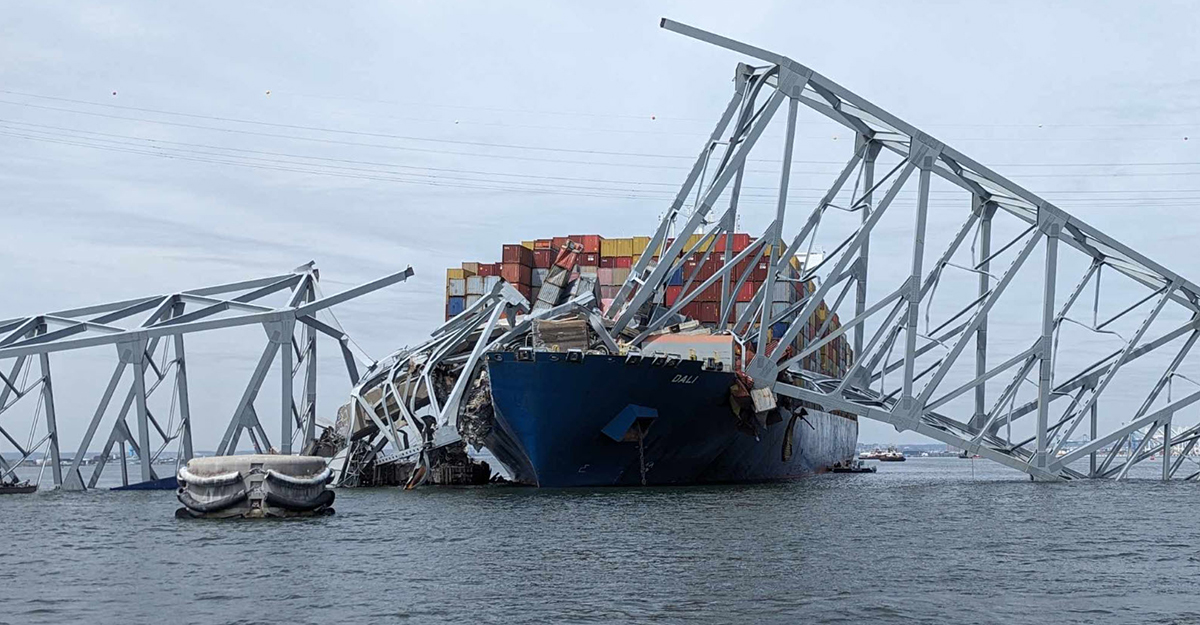 U.S. Army Corps of Engineers
U.S. Army Corps of EngineersAfter the 2024 Baltimore bridge tragedy, the leader of Maryland’s flagship university’s civil and environmental engineering department sought to foster a better understanding of how cities can be more resilient when faced with infrastructure failures.
With the goal of a broader look at the Francis Scott Key Bridge collapse, Nii O. Attoh-Okine, Ph.D., P.E., F.ASCE, chair of the civil and environmental engineering department at the University of Maryland, convened 27 leading infrastructure experts to present their research. The May 2024 workshop – titled “Lessons Learned from the Francis Scott Key Bridge Collapse: Enhancing Resilience of Critical Infrastructure Systems” – occurred nearly two months after a ship struck the Key Bridge, killing six maintenance workers.
Further reading:
- As Baltimore tragedy lingers, report warns more major US bridges at risk of ship strikes
- Shock, heartbreak fill civil engineering community as tragedy strikes iconic Baltimore bridge
- Infrastructure report card numbers are telling; what do they say about your sector?
“This event turned the whole world upside down – and not just in Baltimore. This is one of the most important ports on the Eastern Seaboard,” Attoh-Okine said. “And beyond the damage to the bridge itself, this collapse affected highway traffic, shipping traffic; there were hazardous materials that went into the water that could impact the disadvantaged people who live in that area.
“When you think about the impact, you see it’s much more than just a bridge collapse. There are multiple cascade events that must be considered.”
The workshop, which drew more than 150 audience participants, was divided into four specific subject matter areas: Setting the Stage, providing a historical perspective of infrastructure failures; Transportation Lessons and Solutions, highlighting solutions to minimize impact when critical transportation infrastructure fails; Bridges and Waterways, presenting important information about bridge design code needs as well as emerging design and analysis approaches; and Risk, Reliability, and Supply Chain, emphasizing the importance of taking a systems approach when considering critical infrastructure needs.
The second session included an ASCE-University of Maryland roundtable.
“The workshop invited a lot of researchers who understand critical infrastructure not only to look at this accident and what we learned but also to look at the resilience of all these different and interconnected infrastructure systems,” Attoh-Okine said.
A time for introspection
Anil Agrawal, Ph.D., P.E., F.SEI, Dist.M.ASCE, a professor of civil engineering at City College of New York, presented his groundbreaking work in simulation, demonstrating what advanced computer modeling can offer when trying to understand and mitigate risk.
“The current American Association of State Highway and Transportation Officials guideline to design for ship impact is close to 40 years old,” he said. “At the time (of its introduction), we did not have simulation technology, so we had to rely on simplified models of these kinds of events. … Today, we have the capability to build a model of not just the bridge but the whole ship. We can not only simulate the impact force more accurately but also understand the material behavior much better to predict what might happen.”
Agrawal added that today’s ships are larger, carry heavier loads, and have faster engines. Simulations can help designers understand the potential risk of failure not just from a ship collision but other phenomena with the power to disable critical infrastructure, including earthquakes or other natural catastrophes.
They can also help civil engineers, as well as other infrastructure stakeholders, understand what can be done to mitigate those risks, like adding dolphins, fenders, or artificial islands to better protect bridge piers.
“These things cost money,” he said, referring to simulation and mitigation options. “But when you look at the total cost to rebuild a bridge like the Key Bridge, as well as the loss of life, you see it is so much more. When you have such a high-risk asset, even if there is a small probability of damage, it’s important to do what you can.”
Some might have been surprised that the workshop lineup included scientists studying more than just bridge design and resilience.
Some of the presenters discussed other infrastructure incidents, ranging from destruction of subsea cables to nuclear failure, punctuating how interconnected different infrastructure systems are. Attoh-Okine said this helps stakeholders think “beyond one type of system.”
“These things are all interdependent. They rely on one another,” he said. “So, when you look at resilience, you have to look at it from the system of systems point of view.”
In the weeks following the workshop, Attoh-Okine and colleagues published a preliminary report with recommendations to address future infrastructure incidents.
The group recommended that engineers and other stakeholders do a thorough analysis to understand the dependencies of any piece of critical infrastructure – and do so by adopting new and more comprehensive models. That, Attoh-Okine said, is necessary to develop the right measures to design new infrastructure, replace or repair existing infrastructure, and manage the effects of failures.
Beyond addressing the potential cascade effects of failure, the group also recommended real-time tracking of ships and other vessels, pedestrians, and automobile traffic; greater investment in bridge protections; more modeling using big datasets to understand potential current and future impacts of failures; and adopting the use of digital twins to help optimize operation, monitor the health, and guide preservation decisions for critical infrastructure systems like the Key Bridge.
Important takeaways
Agrawal, for his part, said he strongly believes the Key Bridge collapse offers civil engineers many lessons to help avoid such tragedies in the future.
“The only way to prevent a collapse is to understand how a bridge can collapse,” he said. “We need to understand all the damage modes – and simulation can help us do that.”
The same, Attoh-Okine offered, could be said about any type of infrastructure failure. But if engineers do not take a system of systems approach, they will not only have difficulty protecting a single bridge or roadway – they will struggle to protect the surrounding community.
“You cannot leave one system to go bad when you are focusing on another system,” Attoh-Okine said. “You need to look at all the pieces together. They affect one another.
“Of course, we need to deal with improvements to core infrastructure, but we need to think through how the things we do will influence other things, whether we are trying to manage a failure or consider how to best invest funding into our infrastructure systems. If we only look at one thing at a time, we are not going to get anywhere. We need to look at it all.”



